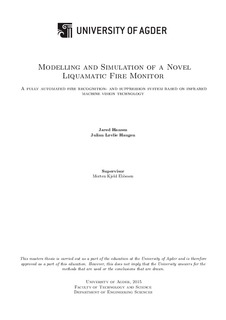Modelling and Simulation of a Novel Liquamatic Fire Monitor A fully automated fire recognition- and suppression system based on infrared machine vision technology
Master thesis
Permanent lenke
http://hdl.handle.net/11250/301974Utgivelsesdato
2015Metadata
Vis full innførselSamlinger
Sammendrag
Background: Fire monitors are effective fire extinguishing apparatuses which combine high accuracy with
long range. As part of the mechatronic trend, research has during recent years started to delve into the automation
of re monitors. This involves proper actuation and control of re monitors in order to extinguish
re. Up to this point, however, research has primarily been concerned with indoor operation. The aim of
the present thesis is to develop a system for an electrically actuated re monitor which detects, localizes
and suppresses re in an outdoor environment without the need for manual operation.
Solution & Experiments: Fire is localized with computer analysis of IR stereo camera images. Based
on the position of the re, mathematical models found in literature are used to determine the optimum
con guration of the monitor in order to extinguish the re. Servomotors which actuate the monitor are
modelled and simulated in real time using a HIL setup. A PLC is programmed to generate control signals
to the servomotors.
The accuracy of the stereo vision system is tested experimentally by estimating the distance to a live re at
distances between 30 and 60 m. In addition, the system's ability to distinguish a re from other hot objects
is tested.
Liquid jet trajectory models are obtained from relevant research papers found in open literature. Parameters
from these models are determined based on experiments conducted outdoors with a re monitor where wind
disturbances are measured.
Results: The stereo vision system exhibited a maximum error of 0.5 m or 1.6 %. The vision system is
successful in distinguishing between a wooden re, a person and a pot with boiling water.
The best model to predict jet trajectories found in literature yields an average error of 1.6 m from measured
data with little wind present, and 9.8 m mean deviation with comparatively strong wind disturbances.
Simulations are carried out with only minor discrepancies with one of the models implemented on the PLC.
Conclusion: Computer algorithms which localize re in conjunction with IR cameras has been designed.
The limiting factor with regards to the system's accuracy is precise predictions of the water jet's travel.
The accuracy of the trajectory models as compared to experimental data measured under presented circumstances
are of limited use. In addition, there are marginal di erences between the presented trajectory
models found in literature, and therefore either one may be used.
A PLC program has been created. HIL simulations are carried out with only minor discrepancies as compared
to the predicted trajectories from one of the models.
Beskrivelse
Masteroppgave i mekatronikk - Universitetet i Agder, 2015
